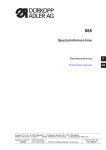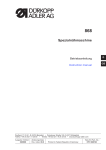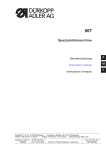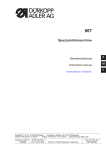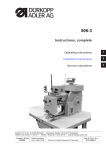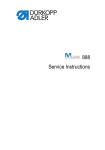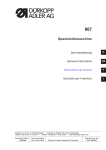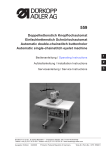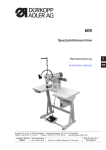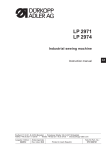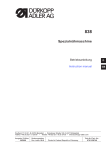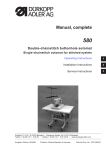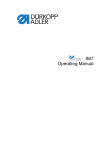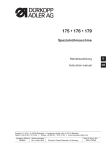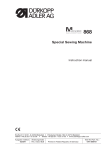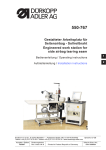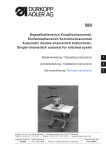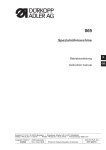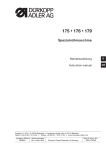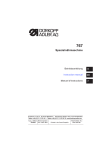Download DURKOPP ADLER 888 Instruction manual
Transcript
888 Spezialnähmaschine Betriebsanleitung D Instruction manual GB Postfach 17 03 51, D-33703 Bielefeld • Potsdamer Straße 190, D-33719 Bielefeld Telefon +49 (0) 521 / 9 25-00 • Telefax +49 (0) 521 / 9 25 24 35 • www.duerkopp-adler.com Ausgabe / Edition: 09/2010 Änderungsindex Rev. index: 04.0 Printed in Federal Republic of Germany Teile-Nr./Part.-No.: 0791 888740 Alle Rechte vorbehalten. Eigentum der Dürkopp Adler AG und urheberrechtlich geschützt. Jede, auch auszugsweise Wiederverwendung dieser Inhalte ist ohne vorheriges schriftliches Einverständnis der Dürkopp Adler AG verboten. All rights reserved. Property of Dürkopp Adler AG and copyrighted. Reproduction or publication of the content in any manner, even in extracts, without prior written permission of Dürkopp Adler AG, is prohibited. Copyright © Dürkopp Adler AG - 2010 Foreword This instruction manual is intended to help the user to become familiar with the machine and take advantage of its application possibilities in accordance with the recommendations. The instruction manual contains important information on how to operate the machine securely, properly and economically. Observation of the instructions eliminates danger, reduces costs for repair and down-times, and increases the reliability and life of the machine. The instruction manual is intended to complement existing national accident prevention and environment protection regulations. The instruction manual must always be available at the machine/sewing unit. The instruction manual must be read and applied by any person that is authorized to work on the machine/sewing unit. This means: – – – Operation, including equipping, troubleshooting during the work cycle, removing of fabric waste, Service (maintenance, inspection, repair) and/or Transport. The user also has to assure that only authorized personnel work on the machine. The user is obliged to check the machine at least once per shift for apparent damages and to immediatly report any changes (including the performance in service), which impair the safety. The user company must ensure that the machine is only operated in perfect working order. Never remove or disable any safety devices. If safety devices need to be removed for equipping, repairing or maintaining, the safety devices must be remounted directly after completion of the maintenance and repair work. Unauthorized modification of the machine rules out liability of the manufacturer for damage resulting from this. Observe all safety and danger recommendations on the machine/unit! The yellow-and-black striped surfaces designate permanend danger areas, eg danger of squashing, cutting, shearing or collision. Besides the recommendations in this instruction manual also observe the general safety and accident prevention regulations! General safety instructions The non-observance of the following safety instructions can cause bodily injuries or damages to the machine. 1. The machine must only be commissioned in full knowledge of the instruction book and operated by persons with appropriate training. 2. Before putting into service also read the safety rules and instructions of the motor supplier. 3. The machine must be used only for the purpose intended. Use of the machine without the safety devices is not permitted. Observe all the relevant safety regulations. 4. When gauge parts are exchanged (e.g. needle, presser foot, needle plate, feed dog and bobbin) when threading, when the workplace is left, and during service work, the machine must be disconnected from the mains by switching off the master switch or disconnecting the mains plug. 5. Daily servicing work must be carried out only by appropriately trained persons. 6. Repairs, conversion and special maintenance work must only be carried out by technicians or persons with appropriate training. 7. For service or repair work on pneumatic systems, disconnect the machine from the compressed air supply system (max. 7-10 bar). Before disconnecting, reduce the pressure of the maintenance unit. Exceptions to this are only adjustments and functions checks made by appropriately trained technicians. 8. Work on the electrical equipment must be carried out only by electricians or appropriately trained persons. 9. Work on parts and systems under electric current is not permitted, except as specified in regulations DIN VDE 0105. 10. Conversion or changes to the machine must be authorized by us and made only in adherence to all safety regulations. 11. For repairs, only replacement parts approved by us must be used. 12. Commissioning of the sewing head is prohibited until such time as the entire sewing unit is found to comply with EC directives. 13. The line cord should be equipped with a country-specific mains plug. This work must be carried out by appropriately trained technicians (see paragraph 8). It is absolutely necessary to respect the safety instructions marked by these signs. Danger of bodily injuries ! Please note also the general safety instructions. Contents Page: Part 2: Installation Instructions Class 888 – Original Instructions 1 Scope of delivery . . . . . . . . . . . . . . . . . . . . . . . . . . . . . . . . . . . . . . . . . . . . . 3 2 Transport packing of assembled machine 4 3 3.1 3.2 3.2.1 3.2.2 3.2.3 3.3 Assembling the stand Assembling the stand components . . . . . . . . . . . . . . . . . . . . . . . . . Assembling the table top . . . . . . . . . . . . . . . . . . . . . . . . . . . . . . . Assembling the table top in the machine with the motor on the table top . . Assembling the table top with the motor on the machine head (direct drive) Mounting the pressure regulator for the sewing foot to the table top . . . . . Setting the working height . . . . . . . . . . . . . . . . . . . . . . . . . . . . . . 4 4.1 4.2 4.3 4.4 4.5 4.6 4.7 Assembling the machine head Fitting the machine head . . . . . . . . . . . . Fitting the machine head drive with a V-belt . Fitting the belt guards . . . . . . . . . . . . . . Adjustment of pedal position . . . . . . . . . . Fitting the knee lever and oil pump pipe . . . Fitting the proximity switch . . . . . . . . . . . Fitting the connecting cable, control panel and sewing diode lamp on the machine head . . . . . . . . . . . . . . . . . . . . . . . . . . . . . . . . . . . . . . . . . . . . . . . . . . . . . . . . . . . . . . . . . . . . . . . . . . . . . . . . . . . . . . . . . 4 5 5 6 7 9 . . . . . . . . . . . . . . . . . . . . . . . . . . . . . . . . . . . . . . . . . . . . . . . . . . . . . . . . . . . . 10 11 12 13 14 15 . . . . . . . . . . . . . . . . . . . . . . . . . . . . . 16 . . . . . . . . . . . . . . . . . . . . . . . . . . . . . . . . . . . . . . . . . . . . . . . . . . . . . . . . . . . . . . . . . . . . . . . . . . . . . . . . . . . . . . . . . . . . . . . . . . . . . . . . . . . . . . . . . . 5 5.1 5.1.1 5.2. 5.3 5.4 5.5 Electrical connection Electrical connection to low voltage network . . . . . . . Sewing light transformer connection to network voltage Grounding . . . . . . . . . . . . . . . . . . . . . . . . . . . . Connection of head to Efka DC1550/DA321G drive . . . Mounting the M-Control PCB . . . . . . . . . . . . . . . . . Setting the switch on the M-Control PCB . . . . . . . . . . . . . . . . . . . . . . . . . . . . . . . . . . . . . . . . . . . . . . . . . . . . . . . . . . . . . . . . . . . . . . . . . . . . . . . . . . . . . . . . . . . . . . . . . . . . . . . . . . . . . . . . . . . . . . . . . . . . . . . . . . . . . . . . 17 18 19 20 21 22 6 6.1 6.1.1 6.1.2 6.1.3 6.2 6.2.1 6.2.2 6.2.3 6.3 Adjustment of Efka positioning motor (drive) Setting of positioning motor (drive) parameters . . . . . . . . Setting of parameters by the “autoselect” function . . . . . . Setting of Efka drive parameters specific for class 888 . . . Values of parameters specific for this class 888 . . . . . . . . Setting of machine positioning . . . . . . . . . . . . . . . . . . Position definition . . . . . . . . . . . . . . . . . . . . . . . . . . Setting the machine positioning for DC1550/DA321G drive Checking of set positions . . . . . . . . . . . . . . . . . . . . . Master reset . . . . . . . . . . . . . . . . . . . . . . . . . . . . . . . . . . . . . . . . . . . . . . . . . . . . . . . . . . . . . . . . . . . . . . . . . . . . . . . . . . . . . . . . . . . . . . . . . . . . . . . . . . . . . . . . . . . . . . . . . . . . . . . . . . . . . . . . . . . . . . . . . . . . . . . . . . . . . . . . . . . . . . . . . . . . . . . . . . . . . . . . . . . . . . . . . . . . . . . . . . . . . . . . . 23 23 23 24 24 24 24 25 25 7 Pneumatic connection . . . . . . . . . . . . . . . . . . . . . . . . . . . . . . . . . . . . . . . . . . 26 8 Lubrication . . . . . . . . . . . . . . . . . . . . . . . . . . . . . . . . . . . . . . . . . . . . . . . . . 27 . . . . . . GB Contents 9 Sewing test . . . . . . . . . . . . . . . . . . . . . . . . . . . . . . . . . . . . . . . . . . . . . . . . . Page: 27 1 Scope of delivery The purchaser can order a complete machine, or some components only. Prior to setting up, please check that all the required parts are present. This description refers to a special sewing machine, of which all individual components can completely be delivered by Dürkopp Adler AG. A complete supply of the disassembled machine depends on the selected drive and consists of the following components: 3 8 1 4 2 7 GB 6 5 9 10 Machine with the motor (drive) on the table top Machine with the direct drive on the machine head Obligatory components: Machine head (1) Machine head (1) Accessories (includes oil tank (2), yarn stand (3), tools and other items Accessories (includes oil tank (2), yarn stand (3), tools and other items Set of parts for motor (includes belt guard (4), drive Set of parts with motor (includes direct drive (5), belt pulley and other parts dependent on drive) belt guard (4) and other parts) Optional components: Stand (6) Stand (6) Drive (7) Control panel (8) Control panel (8) Maintenance unit (9)* Pneumatic connection package (10)* *only for subclasses with pneumatics 3 2 Transport packing of assembled machine If the machine is supplied in assembled condition, the following transport packing must be removed: – Safety straps and wooden battens on the machine head and stand. – Safety blocks and straps on the sewing drive. 3 Assembling the stand 3.1 Assembling the stand components 3 1 2 – – 4 Mount the frame according to the picture. Mount the pedal (1) provisionally. Its position will be adjusted after the whole machine is complete. Adjust the screw (2) so that the stand is stable. 3.2 Assembling the table top 3.2.1 Assembling the table top in the machine with the motor on the table top 1 7 8 9 5 6 4 3 10 2 260 10 11 36 15 8 14 80 15 15 12 13 96 32 8 16 770 0 80 14 28 30 50 17 185 – – – – – – – – – – – – – – – – – GB Turn the table top (1) upside down. Screw the drawer (2). Put the oil sump (3) on the recess in the table top and slide it in the arrow direction (4) till the relevant protrusions of the oil sump are seated on the recess contour. Screw the oil sump. Screw the drive (5). Screw the sewing lamp transformer (6) – if there is any. Screw the cable clip (7). Screw the electric cable channel (8). Screw the switch (9). Mount electric cables according to the instructions in chapter 5. Pre-bore the holes (10). Attach the table plate to the stand with woodscrews (B8 x 35). Then turn the stand to normal position. Insert the yarn stand (11) in the hole in the table plate and secure it with the nuts and washers. Fit and align the yarn reel and unwinding holders. Insert the machine head support pin (12). Place the hinge bottoms (13) for the machine head into the cutout of the table plate (1) and tighten the screws. Insert the wedges (14) in the recess corners. Insert the rubber cushions (15). Remove the blinds from the bushing (16). Remove the knee lever (17) and guide through the opening, as shown in the illustration. 5 3.2.2 Assembling the table top with the motor on the machine head (direct drive) 10 8 9 2 3 5 6 1 10 7 260 4 11 15 36 8 14 50 460 80 15 15 180 12 13 15 16 32 8 17 80 30 30 72 770 185 – – – – – – – – – – – – – – – – – 6 Turn the table top (1) upside down. Screw the electric cable channel (2). Screw the pedal position sensor (3). Screw the electric cable clip (4). Put the oil sump on (5) and slide it in the arrow direction (6) till the relevant protrusions of the oil sump are seated on the recess contour. Screw the oil sump. Screw the drawer (7). Pre-bore the holes for wood screws and screw the drive control box (8). Screw the sewing lamp transformer (9) – if there is any. Mount electric cables according to the instructions in chapter 5. Pre-bore the holes (10). Attach the table plate to the stand with woodscrews (B8 x 35). Then turn the stand to normal position. Insert the yarn stand (11) in the hole in the table plate and secure it with the nuts and washers. Fit and align the yarn reel and unwinding holders. Insert the machine head support pin (12). Place the hinge bottoms (13) for the machine head into the cutout of the table plate (1) and tighten the screws. Insert the wedges (14) in the recess corners. Insert the rubber cushions (15). Remove the blind from the bushing (16). Remove the knee lever (17) and guide through the opening, as shown in the illustration. 3.2.3 Mounting the pressure regulator for the sewing foot to the table top 9 1 10 – – Put the pressure regulator (1) in the holder (9) and secure it using the nut (10). Mount the components of the pneumatic circuit to the table top as shown in the illustration below. Shall not project beyond the edge of the table top 7 GB Connect the components of the pneumatic circuit according to the drawing below. 8 3.3 Setting the working height 1 – – – – The stand height is adjustable between 750 and 900 mm. Loosen the screws (1). Set the required table top height and make sure that it is identical on both sides. To do that, use the scale on the stand feet. Set the stand height so that it corresponds with the operator’s body proportions. Tighten both screws (1). GB Caution! Risk of injury! Failure to adjust the stand height to the operator’s body proportions can cause damage to the operator’s locomotion system. 9 4 Assembling the machine head 4.1 Fitting the machine head 1 2 3 – – – 10 If the sewing machine is equipped with a motor on the table top, insert the machine head (1) vertically in the recess in the table top. If the sewing machine is equipped with a motor (drive) on the machine head, tilt the machine head (2) and insert it in the table top recess. After the head insertion, screw the locking plate (3) immediately to secure the machine head against falling out at its tilting. The locking plate is part of the machine head accessories. 4.2 Fitting the machine head drive with a V-belt This paragraph applies only to the machines with the motor on the table top. 2 mm 20 N 10 F= 4 3 3 1 6 5 GB – – – – Mount the V-belt pulley (1) and the V-belt (2). Both items are included in the set of parts. Loosen the screws (3) and stretch the belt. The connecting rod (4) should be vertical approximately. The surface (5) horizontal approximately. Check the belt tension by force F = 10 N (~ 1 kg). The belt is expected to bend by 20 mm approximately. Adjust the stop (6) position protecting the belt against falling out at tilting the machine. 11 4.3 Fitting the belt guards 1 1 4 2 5 3 6 – – – – – 12 Disassembly the hand wheel (1). In the machines with the motor on the table top mount the guard (2) on the machine head (the guard is included in of the motor part set) and mount the guard (3) on the motor (the guard is included in the motor package). In the machines with the motor on the sewing head and with 1,55:1 toothed belt driving gear, mount the proximity switch (6). It is included in the “kit for motor“. In all machines with the motor on the machine head mount the guards (4) and (5) (they are included in of the motor part set). Mount the hand wheel (1). Doing this, observe the correct angle position: if the needle is in the upper dead point, there should be the 0° value on the hand wheel scale. 4.4 Adjustment of pedal position 90 ° 2 3 2 1 – – Adjust the side position of the pedal (1) so that its center lies on the needle axis. Adjust the draw rod (2) so that the foot axis is perpendicular to the pedal surface. Caution! Risk of injury! Failure to keep the determined pedal position can cause damage to the operator’s locomotion system. 13 GB 4.5 Fitting the knee lever and oil pump pipe 1 4 6 5 7 9 3 8 10 10°± 5° – – – – – – – 14 Lift the sewing foot with the hand lever. Tilt the machine head (1). Slide the shaft (3) in the lever (4). Screw the screw (5) with the washer (6) in the shaft (3). Attach the pipe (7) with the clips (8) and install the suction basket (9). Tilt the machine head and adjust the knee lever (10) according to the picture. Adjust the knee pad. 4.6 Fitting the proximity switch 2 – – – – – 1 4 3 5 6 The proximity switch (1) is mounted to certain positioning motors (drives) only. In that case it is part of the drive supply. Slide the proximity switch (1) in the arrow (2) direction on the hand wheel shaft so that the carrier pin (3) fits in the proximity switch groove. Attach the proximity switch with two screws (4). Remove the back cover and pull the proximity switch cable (5) through according to the picture. Attach the cable with a clip (6). 15 GB 4.7 Fitting the connecting cable, control panel and sewing diode lamp on the machine head 1 2 4 3 6 5 9 7 8 – – – – – – – 16 The connecting cable (1) is supplied with every machine with the positioning motor (drive). The control panel (2) had to be ordered separately (optional equipment). When ordering a control panel, a bracket (3) is always supplied together with it. The sewing lamp LED (5) is an optional equipment. Two types of brackets are supplied together with it to enable the installation of the lighting body in two positions. Position (5) is the basic one. Position (7) should be used if a guide for sewing material is mounted on the machine. Dismantle the upper cover and back cover of the machine head. Install the connecting cable with the connector (1) according to the picture. Install the control panel (2) with the bracket (3) and install the cable (4) according to the picture. Mount the sewing lamp (5) and install the cable (6) according to the picture. Push the cables through the table top and attach them with a self-sticking clip (8). 5 Electrical connection The machine drive is supplied from the low voltage network. Caution! All work on the electrical equipment of this special sewing machine may only be carried out by qualified electricians or other appropriately trained persons. Remove the mains plug before carrying out any work! 5.1 Electrical connection to low voltage network According to the selected type the machine drive has a one-phase or three-phase supply. If the drive has the three-phase supply, it has an asynchronous motor. In that case it is necessary to adjust the connection of the coils in the motor terminal board (star or triangle) to the voltage of the local electric network. Caution! The voltage in the electric network must agree with the voltage on the motor label! The connection of the coils of the asynchronous motor must correspond with the voltage in the local network. GB The low voltage circuit includes the following items: – Supply plug – Main switch (with the drive on the machine head the main switch is incorporated in the drive) – Drive – Sewing lamp transformer (option) – Cables Part of these items is included in the drive package. The other part is included in the package of the motor part set obligatorily supplied with the machine head. The division of the items can be seen in the parts list. The low voltage circuit connection will be made according to the wiring diagram, which is included in the package of the motor part set. Caution! Risk of electric current injury! The drives may be operated only with a safety conductor connected to the functional protective system in accordance with the regulations and rules to avoid personal injuries by electric current or fire. The drive operation will become dangerous if the safety conductor inside or outside the drive is disrupted. The protection must not be disrupted with e.g. an extension cord without the protective conductor. 17 5.1.1 Sewing lamp transformer connection to network voltage Caution! Risk of electric current injury! The sewing lamp transformer is not switched off by the main switch (EN 60 204-31)! At the sewing lamp installation and repair inside the transformer box, e.g. at a fuse replacement, the mains plug must be disconnected from the power outlet. A. The machine is equipped with the following drives: FIR 1147 - F554.3 FIR 1148 - F752.3 – Pull the mains plug from the power outlet. – Conduct the transformer cable to the main switch. – Connect the transformer cable according to the wiring schedule, which is included in the delivery of the set of parts supplied with the machine head. – Stick a self-sticking label with safety instructions on the front side of the main switch. B. The machine is equipped with the Efka DC1550/DA321G drive 2 6 5 – – – – – – – – – – – – 18 1 6 5 4 3 Pull the mains plug from the power outlet. Screw out 4 screws on the front panel of the control box. Dismantle the front panel. Pull the transformer cable through the channel (1) in the control box. Remove the black rubber bushing (2). Pierce the bushing with a screwdriver. Pull the sewing lamp transformer cable through the arisen hole. Insert the rubber bushing back again. Press the clip openers (3) and (4) with a small screwdriver slightly until the clips (5) and (6) open. Connect the blue conductor to the terminal (6) and the brown conductor to the terminal (5). Screw the front panel back again. Fix the light transformer cable against pulling off (e.g. with a fastening band to a supply mains cable). 5.2 Grounding 1 2 – – – – The grounding conductor (1) is included in the accessory package of the machine head. Connect the conductor (1) to the plug (2) and pull its opposite end under the table top. Screw the opposite end of the grounding conductor to the relevant grounding point of the drive (indicated ). Attach the conductor with a clip on the bottom side of the table top. GB Caution! Make sure that the grounding conductor does not touch the driving V-belt (if there is any). Note: If the machine has the direct drive with the motor drive on the machine head, it is not necessary to ground the head. In that case the head is grounded with the motor on the head. 19 5.3 Connection of the head to Efka DC1550/DA321G drive Efka DC1550/DA321G direct drive is fixed directly on the machine head. The motor synchronizer is incorporated in the motor body and it is not located on the hand wheel (this applies, however, only for the 1:1 gear reduction motor – machine). B 4 1 M B 2 B 8 0 M E B ... B 1 8 L S M ... B 7 7 6 V 8 . . A 74 1 2 – – – – – – 20 9 3 5 6 8 Connect the machine head connecting cable to the connector (1). Connect the control panel to the connector (2). Connect connector (3) of the motor synchronizer (6) to connector (4). Connect the connector (5) of the motor (6) to the connector (7). Connect the pedal position sensor (8) to the connector (9). Connect hand wheel position in connector B18. 5.4 Mounting the M-Control PCB 7 2 6 5 4 3 1 – – – – Mount the M-Control PCB 1 to the right of the set value initiator 2. Connect the compressed air hose 4 to the compressed air maintenance unit 8. Fix the two compressed air hoses 7 from the machine head onto the throttle valves / solenoid valves 5 and 6. Plug the electric cables 3 into the corresponding sockets. Note If the function of the keys “L” and “R” are permuted, swap the compressed air hoses 7 at the solenoid valves. 8 21 GB 5.5 Setting the switch on the M-Control PCB 1 With machines having a disconnectable needle bar the switch 1 on the M-Control PCB has to be in position “2". 22 6 Adjustment of Efka positioning motor (drive) The function of the positioning motor (drive) is defined by its program, drive parameter setting, and the machine stopping positions. If the machine is supplied in the disassembled condition, the drive setting must be carried out by the purchaser. If the sewing machine is supplied in assembled condition, the drive is already set by the sewing machine manufacturer. 6.1 Setting of positioning motor (drive) parameters The setting of the drive parameters is carried out in two steps. In the first step, the parameters for the family of sewing machine class groups are set by the function “autoselect“. In the second step, some of the set parameters are changed to be adjusted to the particular class. 6.1.1 Setting of parameters by the “autoselect” function The drive control system is equipped with the “autoselect“ device, which is able to identify what sort of the sewing machine was connected to the drive (with a connection cable). At the drive switching on, the value of the resistance of the resistor located inside the sewing machine head for this purpose is measured automatically. As a result of this, the required parameter values are set automatically. If the control system is not able to identify the valid resistance, the drive control will run with so-called safety operation functions only to avoid the sewing machine damage. 6.1.2 Setting of Efka drive parameters specific for class 888 Caution! Change of the parameter value must be performed with consideration and in a responsible way. A false setting of the control may cause the machine damage! Warning! By the so-called master-reset (see chapter 6.3) it is possible to reset all parameter values back to the preset values again. For a detailed description of the various parameters of the control unit, please consult the enclosed current issue of the instructions of the motor manufacturer (see also www.efka.net). 23 GB 6.1.3 Values of parameters specific for this class 888 Parameter change for machines with gear rate of 28/28 teeth Parameter Original value New value Parameter description 290* 0 3 Class of the machine 111 - - Max. sewing speed 170 - - Reference position (see chapter 6.2.2) Parameter change for machines with gear rate 18/28 teeth Parameter Original value New value Parameter description 290* 0 4 Class of the machine 111 - - Max. sewing speed 170 - - Reference position (see chapter 6.2.2) * The parameter must be entered first. Attention: to set up parameters higher as 200, it is necessary to enter the control with a programmer’s level (via code 3112). 6.2 Setting of machine positioning 6.2.1 Position definition Position 1 The needle is down at the stopping in the seam. The angle 225° is on the hand wheel scale. Position 2 The needle is up after trimming. The angle 35° is on the hand wheel scale. 6.2.2 Setting the machine positioning for DC1550/DA321G drive For the needle and other elements positioning the incremental sensor located on the hand wheel is applied which gives 512 impulses (increments) /value in ° is displayed on the display/ and one additional impulse per rotation. In general, the particular position is defined by the angle between this position and the reference position. The angle is set by the corresponding parameter value (it is not, however, identical with the parameter value). The position parameter values have already been set – see chapter 6.1.3. The reference position still remains to be set. The reference position is defined by the angle 105° on the hand wheel scale. After dismantling, mounting, or replacement of the motor drive the reference position must be set again. A reference position setting is described in the operating manual of the motor manufacturer Efka. 24 6.2.3 Checking of set positions Position 1 – Switch on the network switch. – Tread the pedal forwards shortly and release. The machine is stopped in the position 1 (see chapter 6.2.1). – Check the angle on the hand wheel scale (225° ± 5°). Position 2 – Tread the pedal forwards shortly at first and then entirely backwards with the heel until the machine stops. The machine stops in the position 2 (see chapter 6.2.1). – Check the angle on the hand wheel scale (35° ± 5°). 6.3 Master reset By means of the so-called master-reset all changed values are set back to the preset ones again. How to proceed with the master reset is described in the instructions of the motor manufacturer Efka. GB 25 7 Pneumatic connection CLASSIC machines with pneumatics. Attention! The special sewing machine’s operating pressure is 6 bar. 3 5 2 6 1 4 – – – – – 26 Mount the maintenance unit 1 to the stand brace as shown in the illustration. Screw in the elbow fitting 2 (in the accessories) and connect the hose 3 from the machine head to the elbow fitting 2. Fix the connection hose 4 as shown in the illustration and connect the other end with the coupling to the compressed air supply system. Raise and turn the handle 5 to set the pressure to 6 bar on the manometer 6. Press the handle 5 again. If the machine is equipped with the pneumatic driven sewing foot with constant pressure, connect it to the maintenance unit as shown in the picture below. 8 Lubrication Before start, the machine must be lubricated properly with oil according to chapter 9.2 in the operating instructions. 9 Sewing test This test can be carried out only after the machine is set completely. – Thread in the bobbin-winder thread. (see operating instructions). – Turn on the main switch. – Lock the sewing foot in the lifted position (see operating instructions). – Fill the bobbin at low speed. – Turn off the main switch . – Thread in needle thread and bobbin thread (see operating instructions). – Select the material to be sewn. – Carry out the sewing test first at low speed and then gradually increase the speed. – Check whether the seams are of the desired quality. – If the quality requirements are not met change the thread tensions (see operating instructions). GB Setting the edge trimmer: see service instructions. 27 Notes: 28
































